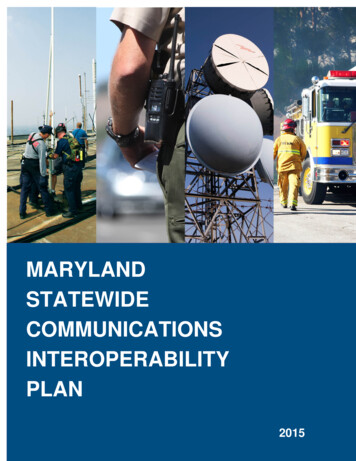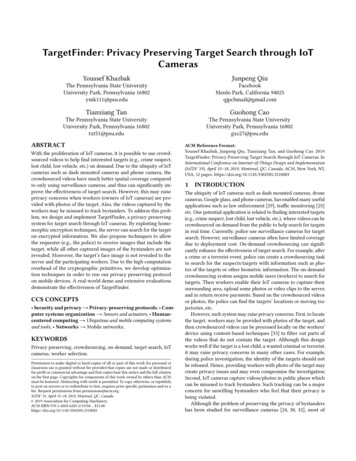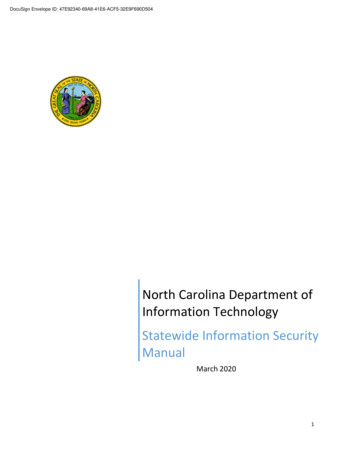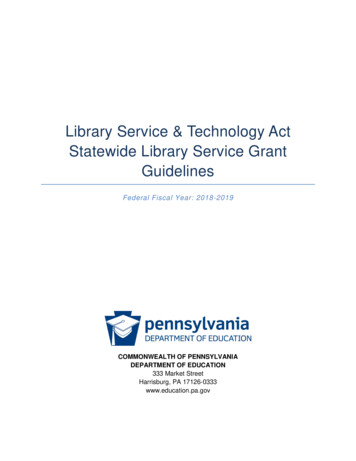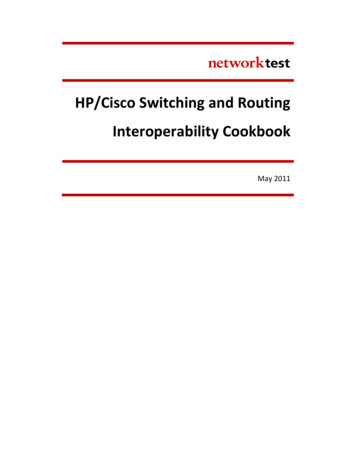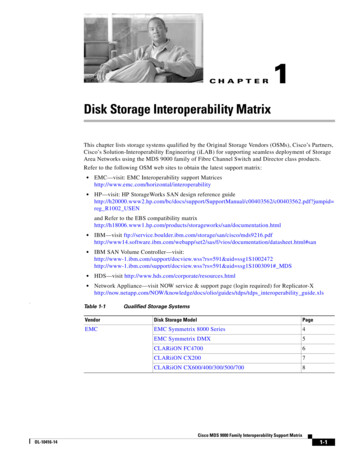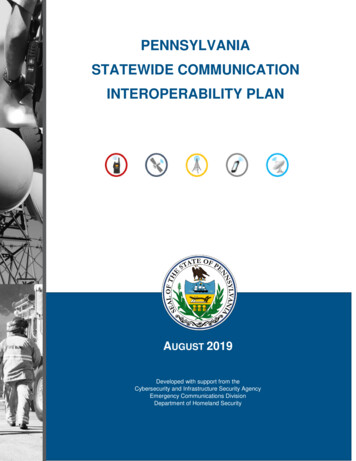
Transcription
PENNSYLVANIASTATEWIDE COMMUNICATIONINTEROPERABILITY PLANAUGUST 2019Developed with support from theCybersecurity and Infrastructure Security AgencyEmergency Communications DivisionDepartment of Homeland Security
PENNSYLVANIA STATEWIDE INTEROPERABILITY PLAN – AUGUST 2019LETTER FROM THE STATEWIDE INTEROPERABILITY COORDINATOR (SWIC)Greetings,I am pleased to provide to you the 2019 Pennsylvania Statewide CommunicationInteroperability Plan (SCIP). This SCIP represents Pennsylvania’s commitment to improvingemergency communications interoperability and supporting our public safety practitionersthroughout the state. In addition, this update meets the requirement of the recently releasedFiscal Year 2018 Department of Homeland Security (DHS) grant guidelines.Representatives from the Pennsylvania State Police, Pennsylvania Emergency ManagementAgency, Office of Attorney General, Department of Conservation and Natural Resources, aswell as Pennsylvania counties collaborated to update the SCIP with actionable andmeasurable goals and objectives with owners and timelines assigned. These goals andobjectives focus on Governance and Technology and are designed to support our state inplanning for new technologies and navigating the ever-changing emergency communicationsecosystem.As we continue to enhance interoperability, we must remain dedicated to improving our abilityto communicate among disciplines and across jurisdictions. With help from state and localpublic safety practitioners, we will work to achieve the goals set forth in this SCIP and becomea nationwide model for statewide interoperability.Sincerely,J. Mark WrightstonePennsylvania Statewide Interoperability CoordinatorStatewide Radio Network DivisionBureau of Communications & Information ServicesPennsylvania State Police8001 Bretz Drive, Harrisburg, PA 17112717-787-85961
PENNSYLVANIA STATEWIDE INTEROPERABILITY PLAN – AUGUST 2019TABLE OF CONTENTSIntroduction. 3Interoperable and Emergency Communications Overview . 4Vision and Mission . 5Governance . 5PA-STARNet Strategic Workgroup . 6Governance: Goals and Objectives . 6Technology . 7Land Mobile Radio . 7Mobile Broadband . 7Next Generation 911 . 7Alerts and Warnings . 8Technology: Goals and Objectives . 9Implementation Plan. 11Appendix A: List of Acronyms . 14Appendix B: Safecom Interoperability Continuum . 15Appendix C: PA-STARNet Shared Services Opportunity. 18Appendix D: Tactical Interoperable Communications Plan (TICP). 19Appendix E: Field Operations Guide (FOG) . 202
PENNSYLVANIA STATEWIDE INTEROPERABILITY PLAN – AUGUST 2019INTRODUCTIONThe Pennsylvania Statewide Communications Interoperability Plan (SCIP) is a stakeholderdriven, multi-jurisdictional, and multi-disciplinary strategic plan to enhance interoperable andemergency communications over the next three years. This document contains the followingplanning components: Introduction – Provides the context necessary to understand what the SCIP is and howit was developed. Interoperable and Emergency Communications Overview – Provides an overview ofPennsylvania’s current and future emergency communications environment. Vision and Mission – Articulates Pennsylvania’s three-year vision and mission forimproving emergency communications operability, interoperability, and continuity ofcommunications at all levels of government. Goals and Objectives – Outlines the goals and objectives aligned with the vision andmission of the SCIP as they pertain to Governance and Technology. Implementation Plan – Describes Pennsylvania’s plan to implement, maintain, andupdate the SCIP and enable continued evolution of and progress toward Pennsylvania’sinteroperability goals.To address interoperability, a framework was needed to identify and describe challenges andto continue improving interoperable public safety communications. The SAFECOM program ofthe Department of Homeland Security developed such a framework with its InteroperabilityContinuum. It is designed to assist public safety agencies and policy makers with planning andimplementing interoperability solutions for communications across technologies. Figure 1depicts the Interoperability Continuum.3
PENNSYLVANIA STATEWIDE INTEROPERABILITY PLAN – AUGUST 2019Figure 1: Interoperability ContinuumFor a detailed description of the Interoperability Continuum, refer to Appendix B.INTEROPERABLE AND EMERGENCY COMMUNICATIONS OVERVIEWReliable, timely communications among first responders and between public safety agenciesand citizens is critical to effectively carrying out public safety missions.Traditional voice capabilities, such as land mobile radio (LMR) and landline 911 services, havelong been and continue to be critical tools for communications. However, the advancement ofinternet protocol (IP) based technologies in public safety has increased the type and amount ofinformation responders receive, the tools they communicate with, and the complexity of newand interdependent systems. New technologies increase the need for coordination acrosspublic safety disciplines, communications functions, and levels of government to ensureemergency communications capabilities are interoperable, reliable, and secure.An example of this evolution is the First Responder Network Authority’s (FirstNet)implementation of the Nationwide Public Safety Broadband Network (NPSBN). With this newsystem, agencies can supplement existing LMR capabilities with expanded voice coverage,increased data speeds, and new mission apps. Its adoption and implementation will requireclose coordination with 911 administrators, dispatch supervisors, LMR systems managers, andmanagers of alert and warning systems to ensure interoperability and cybersecurity are notsacrificed as agencies adopt broadband cellular devices for daily operations.Similarly, the transition of public-safety answering points (PSAPs) to Next Generation 911(NG911) technology will enhance sharing of critical information in real-time through the use of4
PENNSYLVANIA STATEWIDE INTEROPERABILITY PLAN – AUGUST 2019multimedia—such as pictures, video, and text—among citizens, PSAP call takers anddispatchers, and first responders. While the benefits of NG911 are tremendous, interfacingsystems, along with governance, standard operating procedures, and training, are necessaryto realize the expected benefits and ensure the security of emergency information.VISION AND MISSIONVision:Effective interoperable communications among all public safety,service, and support agencies in Pennsylvania.Mission:Offer guidance to decision makers at all levels and promoteinteroperable communications through comprehensive outreach andrecommended standards and procedures to drive current and futurecommunications investments.GOVERNANCEGovernance of the SCIP is the result of statewide collaboration, as depicted in Figure 2.Figure 2: SCIP Collaboration5
PENNSYLVANIA STATEWIDE INTEROPERABILITY PLAN – AUGUST 2019PA-STARNet Strategic WorkgroupIn Management Directive 245-15, Pennsylvania Statewide Radio Network, the PA-STARNetStrategic Workgroup is established as the advisory body for statewide interoperability in theCommonwealth. In this governing body, senior managers in selected commonwealth agenciesare responsible for providing guidance, planning, and strategic implementationrecommendations to mitigate the challenges of interoperable communications for public safetyand emergency communications.At the local level, Pennsylvania uses its nine regional task forces to manage and coordinateemergency communications and interoperability issues. Because Pennsylvania is acommonwealth, the responsibility for providing services, including public safety, is delegated tomunicipal and county jurisdictions. In this environment, most police and fire departmentcommunication systems are county-wide in scope, including locally purchased subscriberequipment. As a result, the Commonwealth’s public safety communications environmentincludes numerous distinct systems under county control.The establishment of working groups under the SWIC to address interoperability issues willcomplement the Commonwealth’s system of consensus-driven communications governance.The following working groups have been identified: SWIC, Policies and Procedures Working GroupTechnical Working GroupPublic Safety Broadband Working GroupCybersecurity Working GroupGovernance: Goals and ObjectivesThe following table identifies goals and objectives related to Governance:GovernanceGoalsObjectives1. Establish working groups under the SWIC.1.1 Align working groups with interoperabilitypriorities.1.1 Assign multi-jurisdictional and multi-disciplinaryworking group membership.2. Conduct outreach and education on theroles and responsibility of the workinggroups.2.1 Attend meetings and conferences to generateinterest and participation in working groupactivities.6
PENNSYLVANIA STATEWIDE INTEROPERABILITY PLAN – AUGUST 2019TECHNOLOGYLand Mobile RadioThe Pennsylvania Statewide Radio Network (PA-STARNet) is the Commonwealth’s statewidenetwork for public safety and emergency response communications. PA-STARNet isupgrading to the industry-standard P25 system; this will replace the proprietary OpenSkysystem. The P25 upgrade is expected to be completed by 2021. The Commonwealth ofPennsylvania has 67 counties across nine regions with unique LMR systems, so there isinterest in exploring options to integrate disparate systems during both planned and unplannedevents. The new P25 radio system represents an opportunity for counties to reduce their costsas well as significantly improve interoperability. To learn about PA-STARNet shared servicesopportunities, see Appendix C.Mobile BroadbandPennsylvania accepted the FirstNet plan for AT&T to build out the NPSBN Radio AccessNetwork (RAN) using the industry-standard technology for mobile broadband: Long TermEvolution (LTE). Subscribing to AT&T/FirstNet services is not mandated for individualjurisdictions or public safety agencies.Rural central Pennsylvania has been identified as the most challenging area to implement thenew network. As a result, AT&T, the selected FirstNet vendor, committed to constructing 25new cell sites in addition to expanding access to remote areas.In addition to the AT&T LTE network that provides service through RAN, AT&T/FirstNetprovides access to a fleet of deployable mobile broadband systems. These deployablesystems are made available to subscribing agencies, to support planned and unplannedevents. They provide additional LTE coverage and capacity to support public safety users.The FirstNet NPSBN built by AT&T has a separate LTE core network, dedicated to publicsafety. The RAN uses both AT&T’s commercial spectrum, and the Band 14 spectrum licensedto FirstNet. Public safety users have priority and preemption over commercial users, onAT&T’s LTE network, regardless of the spectrum that provides their network access.Next Generation 911Working with county partners, Pennsylvania Emergency Management Agency (PEMA)coordinates and maintains Pennsylvania’s E-911 telecommunication system. In 2015,Pennsylvania established a 911 Advisory Board to advise PEMA with technical, funding, andoperations subcommittees. The 911 Advisory Board meets quarterly with representation fromPEMA, the Pennsylvania General Assembly, county officials, and various public safety and7
PENNSYLVANIA STATEWIDE INTEROPERABILITY PLAN – AUGUST 2019service entities. With the consultation of the 911 Advisory board, PEMA has put forth strategicplans to migrate all of Pennsylvania’s 69 PSAPs to NG911 in the near future.1To facilitate the implementation of NG911 in Pennsylvania, PEMA intends to procure astatewide Emergency Services Internet Protocol Network (ESInet) and Next Generation CoreServices (NGCS) system as a service. The ESInet and NGCS system will include all systems,components, and functions necessary to deliver all 911 calls in Pennsylvania from thedemarcation points of originating service providers to the designated terminating network pointof interconnection (POI) using IP based infrastructure.The initial focus of the NG911 solution is to upgrade Pennsylvania’s dated 911 infrastructurefor 911 call delivery. After 911 call delivery is established using the statewide ESInet, the focuscan shift to incorporating additional statewide and regional 911 related systems andapplications onto the statewide system where possible.Alerts and WarningsPennsylvania has several Alerts and Warnings tools available in support of federal, state,county, and municipal level notifications. PEMA owns the satellite-based EmergencyManagement Network (EMnet) that can push notifications out to counties, as well as television,radio stations, and consumer wireless devices across the state. The Pennsylvania State Police(PSP) primarily use the Emergency Alert System (EAS) to broadcast Amber and other alertsover commercial wireless broadband networks. Municipal authorities use their own discretionto disseminate alerts via the EAS/EMnet system as events arise.As directed by Title 35, PEMA shall maintain an integrated communications capabilitydesigned to provide to all areas and counties weather advisories, river forecasts, warnings,and direction and control of all emergency preparedness functions within Pennsylvania. PEMAshall coordinate the commonwealth's emergency communication systems, sharing ofinformation and weather emergency notification among the National Weather Service,contiguous state emergency management offices, municipal coordinators of emergencymanagement, the Pennsylvania State Police, municipal police departments, private reliefassociations and other appropriate organizations.In addition, PEMA shall establish, equip, and staff a commonwealth and area emergencyoperations center with a consolidated statewide system of warnings and provide a system ofdisaster communications integrated with those of federal, commonwealth and municipalagencies involved in disaster emergency operations.PEMA has the authority and responsibility to provide appropriate commonwealth and municipalagencies, public officials, and the general public with precautionary notices, watches, andwarnings relating to actual and potential disasters; and, to provide a flow of official informationand instructions to the general public through all means available before, during, and after anemergency.1The 2019 Pennsylvania Statewide 911 Plan is available s/Commonwealth of Pennsylvania %20Statewide 911 Plan.pdf8
PENNSYLVANIA STATEWIDE INTEROPERABILITY PLAN – AUGUST 2019Technology: Goals and ObjectivesThe following table outlines goals and objectives related to Technology:TechnologyGoalsObjectives3. Develop a P25 radio, talkgroup, and systemID scheme.3.1 Review existing national, state, and local IDschemes.3.2 Investigate applicability of NPSTCinteroperability talkgroups.3.3 Develop a plan that aligns with federalstandards.3.4 Integrate new P25 ID scheme.4. Develop an encryption scheme.4.1 Review existing national, state, and local keymanagement schemes.4.2 Evaluate the need to create statewide keymanagement.4.3 Develop a plan that aligns with federalstandards.4.4 Adopt and implement the key managementscheme.5. Develop a statewide interoperability ISSIstrategy.5.1 Conduct an inventory of existing P25 systemsand other compatible systems.5.2 Develop an implementation plan, to includetechnical data, talk-groups shared, and anydata required to operate an ISSI network.5.3 Identify methods for integrating non-P25systems.6. Develop a template for radio interoperability.6.1 Review existing standard operating procedures(SOPs) (i.e. interoperability, programming,encryption).6.2 Establish SOPs.6.3 Develop and implement training on SOPs.9
PENNSYLVANIA STATEWIDE INTEROPERABILITY PLAN – AUGUST 2019TechnologyGoalsObjectives7. Develop Tactical InteroperableCommunications Plan (TICP) and FieldOperations Guide (FOG).7.1 Request and take advantage of federalTechnical Assistance (TA).7.2 Develop a TICP.7.3 Develop a FOG.8. Develop a public safety broadbandapplications capability plan.8.1 Create a needs assessment tool for PSEs touse.8.2 Identify emerging capabilities.8.3 Develop adoption roadmaps to close gaps.8.4 Educate and train stakeholders and decisionmakers.9. Integrate alerts and warnings capabilities withother elements of the emergencycommunications ecosystem.9.1 Identify alerts and warning capabilities andinvestigate the utility of integrating them intoother systems, such as LMR, LTE, and911/NG911.9.2 Recommend to stakeholders opportunities forintegrating alerts and warnings in theirsystems.10. Assess and mitigate cybersecurity threats toemergency communications systems.10.1 Request and take advantage of federalTechnical Assistance (TA).10.2 Align with cyber security industry bestpractices.11. Support the development of statewide andregional ESInets for interoperability amongpublic safety organizations.11.1 Promote the development and adoption ofstatewide and regional ESInets.11.2 Identify high-value opportunities forinteroperable communications among ESInets,LMR, and broadband wireless.10
PENNSYLVANIA STATEWIDE INTEROPERABILITY PLAN – AUGUST 2019IMPLEMENTATION PLANThe SWIC coordinates efforts to implement the SCIP goals and objectives. These SCIP goals and objectives are intended tosupport the dissemination of best practices across the Commonwealth and can be amended as relevant stakeholders see fit.Additionally, the SCIP will be reviewed and updated annually, if needed, to track each year’s progress and to ensure that it fulfillscurrent and future grant funding requirements. The Emergency Communications Division at the Department of HomelandSecurity has a catalog of Technical Assistance service offerings available to assist in implementing the SCIP. Requests forTechnical Assistance are coordinated through the SWIC.GoalsObjectivesOwnersProjected Completion Date1. Establish working groups underthe SWIC.1.1 Align working groups with interoperabilitypriorities.SWICMay 20201.2 Assign multi-jurisdictional and multidisciplinary working group membership.SWIC2. Conduct outreach andeducation on the roles andresponsibilities of the workinggroups.2.1 Attend meetings and conferences togenerate interest and participation inworking group meetings.SWIC, Working GroupMembersOn-going3. Develop a P25 radio, talkgroup, and system ID scheme.3.1 Review existing national, state, and localID schemes.Technical Working GroupJanuary 20213.2 Investigate applicability of NPSTCinteroperability talk groups.Technical Working Group3.3 Develop a plan that aligns with federalstandards.Technical Working Group3.4 Integrate new P25 ID scheme.Technical Working Group4.1 Review existing national, state, and localkey management schemes.Technical Working Group4.2 Evaluate the need to create statewide keymanagement.Technical Working Group4. Develop an encryption scheme.January 202111
PENNSYLVANIA STATEWIDE INTEROPERABILITY PLAN – AUGUST 2019Goals5. Develop a statewideinteroperability ISSI strategy.ObjectivesOwners4.3 Develop a plan that aligns with federalstandards.Technical Working Group4.4 Adopt and implement the keymanagement scheme.Technical Working Group5.1 Conduct an inventory of existing P25systems and other compatible systems.Technical Working Group5.2 Develop an implementation plan, toTechnical Working GroupProjected Completion DateJanuary 2022, on-goinginclude technical data, talk-groupsshared, and any data required tooperate an ISSI network.6. Develop a template for radiointeroperability.7. Develop Tactical InteroperableCommunications Plan (TICP)and Field Operations Guide(FOG).5.3 Identify methods for integrating non-P25systems.Technical Working Group6.1 Review existing standard operatingprocedures (SOPs) (i.e. interoperability,programming, encryption).SWIC, Policies andProcedures Working Group6.2 Establish SOPs.SWIC, Policies andProcedures Working Group6.3 Develop and implement training on SOPs.Working Group Members7.1 Request and take advantage offederal Technical Assistance (TA).SWIC7.2 Develop a TICP.Working Group Members7.3 Develop a FOG.Working Group MembersDecember 2020, on-goingSeptember 202012
PENNSYLVANIA STATEWIDE INTEROPERABILITY PLAN – AUGUST 2019GoalsObjectivesOwnersProjected Completion Date8. Develop a public safetybroadband applicationscapability plan.8.1 Create a needs assessment tool forPSEs to use.Public Safety BroadbandWorking GroupDecember 2019, on-going8.2 Identify emerging capabilities.Public Safety BroadbandWorking Group8.3 Develop adoption roadmaps to closegaps.Public Safety BroadbandWorking Group8.4 Educate and train stakeholders anddecision makers.Public Safety BroadbandWorking Group9.1 Identify alerts and warning capabilitiesand investigate the utility of integratingthem into other systems, such as LMR,LTE, and 911/NG911.Technical, Policies andProcedures, and PublicSafety Broadband WorkingGroups9.2 Recommend to stakeholdersopportunities for integrating alerts andwarnings in their systems.Technical, Policies andProcedures, and PublicSafety Broadband WorkingGroups10. Assess and mitigatecybersecurity threats toemergency communicationssystems.10.1 Request and take advantage offederal Technical Assistance (TA).Cybersecurity Working Group10.2 Align with cyber security industrybest practices.Cybersecurity Working Group11. Support the development ofstatewide and regional ESInetsfor interoperability among publicsafety organizations.11.1 Promote the development and adoptionof statewide and regional ESInets.Working Group Members11.2 Identify high-value opportunities forinteroperable communications amongESInets, LMR, and broadband wireless.Working Group Members9. Integrate alerts and warningscapabilities with other elementsof the emergencycommunications ecosystem.On-goingSeptember 2020, on-goingSeptember 2020, on-going13
PENNSYLVANIA STATEWIDE INTEROPERABILITY PLAN – AUGUST 2019APPENDIX A: LIST OF PSWICTATICPComputer Aided DispatchCybersecurity and Infrastructure Security AgencyUnited States Department of Homeland SecurityEmergency Communications DivisionEmergency Alert SystemEmergency Management NetworkField Operations GuideFirst Responder Network AuthorityInternet ProtocolInter-RF Subsystem InterfaceLand Mobile RadioLong-Term EvolutionNext Generation 911National Public Safety Broadband NetworkNational Public Safety Telecommunications CouncilProject 25Pennsylvania Statewide Radio NetworkPennsylvania Emergency Management AgencyPublic Safety Answering PointPennsylvania State PoliceRadio Access NetworkStatewide Communication Interoperability PlanStandard Operating ProcedureStatewide Interoperability CoordinatorTechnical AssistanceTactical Interoperable Communications Plan14
PENNSYLVANIA STATEWIDE INTEROPERABILITY PLAN – AUGUST 2019APPENDIX B: SAFECOM INTEROPERABILITY CONTINUUMGovernance: A common governing structure for solving interoperability issues will improve thepolicies, processes, and procedures of any major project by enhancing communication,coordination, and cooperation, establishing guidelines and principles, and reducing anyinternal jurisdictional conflicts. This group should consist of local, tribal, state, and federalentities as well as representatives from all pertinent public safety disciplines within theidentified region. A formal governance structure is critical to the success of interoperabilityplanning.Individual Agencies Working Independently - A lack of coordination among respondingorganizations.Informal Coordination Between Agencies - Loose line level or agency agreements that provideminimal incident interoperability.Key Multidiscipline Staff Collaboration on a Regular Basis - A number of agencies anddisciplines working together in a local area to promote interoperability.Regional Committee Working with a Statewide Interoperability Committee - Multidisciplinaryagencies working together across a region pursuant to formal written agreements as definedwithin the larger scope of a state plan. Such an arrangement promotes optimal interoperability.Standard operating procedures (SOPs): Formal written guidelines or instructions for incidentresponse. SOPs typically have both operational and technical components.Individual Agency SOPs - Uncoordinated procedures across agencies that can hinder effectivemultidiscipline/multiagency response.Joint SOPs for Planned Events - The development of SOPs for planned events. This typicallyrepresents the first phase as agencies begin to work together to develop interoperability.15
PENNSYLVANIA STATEWIDE INTEROPERABILITY PLAN – AUGUST 2019Joint SOPs for Emergencies - SOPs for emergency level response that are developed asagencies continue to promote interoperability.Regional Set of Communications SOPs - Regionwide communications SOPs formultiagency/multidiscipline/multihazard responses; an integral step towards optimalinteroperability.National Incident Management System Integrated SOPs - Regional SOPs molded to conformto the elements of the National Incident Management System.Technology: Although technology is a critical tool for improving interoperability, it is not thesole driver of an optimal solution. Success in each of the other elements is essential to itsproper use and implementation, and should drive technology procurement. Technology ishighly dependent upon existing infrastructure within a region. Multiple technology solutionsmay be required to support large events.Swap Radios - Swapping radios, or maintaining a cache of standby radios, is an age-oldsolution that is time-consuming, management-intensive, and may only provide limited resultsdue to channel availability.Gateway - Gateways retransmit across multiple frequency bands providing an interiminteroperability solution as agencies move toward shared systems. However, gateways areinefficient in that they require twice as much spectrum because each participating agency mustuse at least one channel in each band per common talk path, and because they are tailored forcommunications within the geographic coverage area common to all participating systems.Shared Channels - Interoperability is promoted when agencies share a common frequencyband, air interface (analog or digital), and are able to agree on common channels. However,the general frequency congestion that exists across the United States can place severerestrictions on the number of independent interoperability talk paths available in some bands.Proprietary Shared Systems and Standards-based Shared Systems - Regional sharedsystems are the optimal solution to interoperability. While proprietary systems limit the user'schoice of product with regard to manufacturer and competitive procurement, standards-basedshared systems promote competitive procurement and a wide selection of products to meetspecific user needs. With proper planning of the talk group architecture, interoperability isprovided as a byproduct of system design, creating an optimal technology solution.Evolving Technology Opportunities - In recent years, two important technologies for enhancedinteroperability have emerged. One is the standards-based P25 ISSI, which allows networklevel interconnection between P25 systems. This facilitates communication between adjacentjurisdictions (e.g. county-to-county) and overlapping jurisdictions (e.g. county-to-state). It alsofacilitates system-sharing, wherein public safety users can obtain radio access through aneighboring or overlapping system, while communicating back to their home group.A second technology that is enabling enhanced interoperability is the multi-band radio. Unlikeswapping radios, this technology enables users to operate their radios on adjacent oroverlapping systems which may operate in different frequency bands.In addition to Land Mobile Radio (LMR), broadband networks such as the Nationwide PublicSafety Broadband Network (NPSBN), implemented by AT&T, provide PTT applications andservices that enable nationwide interoperability. These solutions also support LMR-LTEinterconnection, enabling PTT interoperability between users on LMR systems, an
Governance: Goals and Objectives The following table identifies goals and objectives related to Governance: Governance Goals Objectives 1. Establish working groups under the SWIC. 1.1 Align working groups with interoperability priorities. 1.1 Assign multi-jurisdictional and multi-disciplinary working group membership. 2.


